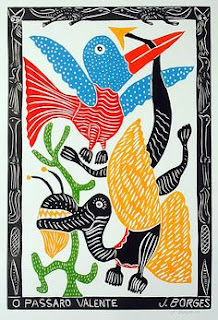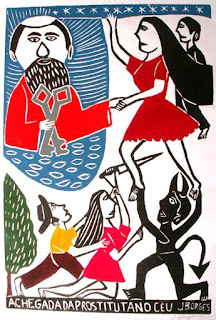A place for talking about art, social issues, and most anything else I think THAT'S INKED UP.
Tuesday, May 10, 2016
Jose Francisco Borges' Prints on the Life and Culture of Brazil
José Francisco Borges was born in 1935 in Bezerros, Brazil. He is Latin America’s best-known folk artist working in relief, and his work has been exhibited all over the world. He comes out of a long tradition of folk poet/artists who publish their own work in the form of small inexpensive chap-books written in verse, known as folhetos or literatura de cordel, because vendors sell them in the marketplace, hanging over a string.
The backcountry of Brazil is as big as the state of Texas, and it is filled with cowboys, bandits, simple folk and a strong sense of faith. The people from this area are descended from the Portuguese, and they have come to enjoy hearing story-telling poems set to song. These poems are sung by traveling minstrels who spread local gossip as they move from town to town. Frequently, vendors sing these songs to market crowds, many of whom are illiterate, and their voices usually draw enormous gatherings.
Brazilian chap books deal with popular poetry, accounts of local catastrophes, popular legends, famous crimes, and infamous love affairs. The front of these pamphlets usually contain simple, eye-catching illustrations of the book's contents, and they have become a special type of folk art.
Borges worked as a child in the remote fields of north-east Brazil. In his 20s, he started trading, making and illustrating books of popular poems, which lead him from Brazil’s backlands to exhibitions at some of the most prestigious art museums in the world. When Borges wrote and illustrated his first book, he sold 5,000 copies in two months! He has created over 250.
In the 1960s, Borges began writing folhetos, and soon also began to operate a printing press to produce woodcut prints for their covers. He then started producing folio-sized prints from their woodcuts, transforming them into an art form by themselves.
His bold, naive compositions, inspired by politics and folklore, are prized by collectors and shown in exhibitions around the world. Borges received a UNESCO cultural award in 2000. Borges still lives and works in Bezerros. He retains a plain view of his inspiration, saying: “I carve what I see.”
Borges work is simple, colorful and exudes a felling of childlike wonder. His images of two-timing women, marriage and fighting the temptations of the Devil are all done in a playful manner, easy for the viewer to digest.
Many galleries handle Borges' work, and you can easily find them online for a song. No pun intended. Snap some up, my dear inked up comrades, as we must support our brethren.
Subscribe to:
Post Comments (Atom)










No comments:
Post a Comment